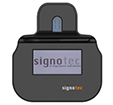 We meet standards: On the safe side with signotec We meet standards: On the safe side with signotec
signotec’s solutions for electronic signatures do not only stand for innovation, but also for investment safety. The compliance with not only industry-specific, but also with technological and legal standards is therefore highly emphasised.Regardless of the industrial sector involved, general technical and legal standards need to be met – last but not least the requirements of the new European Data Protection Regulation (GDPR). signotec’s solutions are compliant with the following standards:PDF signature according to ISO 19005-1:2005 and ISO 32000-1:2008 (PDF-/Adobe-DigSig-Standards)
Among other things, these major standards regulate the signature of PDF documents. This regulates two essential points in terms of security:
The standardized electronic signature in connection with the personal signature allows to identify the author of the signature beyond doubt. Of course, signotec supports genuine multiple signatures and thus has a unique selling point. For every signature, a new signature field is inserted, and the version of the document can be called up at any time for a signature service - without proprietary means!
These standards ensure that the document integrity can be checked with any PDF viewer, such as the Acrobat Reader. Any changes which are made after the signature, will be reliably detected.
eIDAS compliant advanced and qualified electronic signatures
Since 1 July 2016, the new European e-Signature Regulation defines the technological basis for electronic signatures. In particular, qualified (remote) signatures have been simplified. signotec also supports this solution in combination with the signature pads or as the sole means of signature.
Biometric data according to ISO/IEC 19794-7: Biometric data interchange formats – part 7: signature/sign time series data
This standard ensures that the biometric data of the signature (speed, pressure, direction of movement, acceleration, etc.) are saved in a defined format. This allows third parties to process the format.
Image of the signature according to the ICAO standard 9303
This standard defines the image quality of the signature in order to save it in the highest possible quality for identifications. The following criteria must be met:
Size: Not only should the correct aspect ratio be maintained, but the displayed signature should be large enough to be perceived by the human eye.
Scaling for reproduction in digital printing: Again, the aspect ratio must be maintained when zooming or enlargement
Cropping for digital reproduction: The issuing state or organization should take steps to prevent or minimize cropping
Color: The displayed signature or the usual character must be displayed in a color that provides a clear contrast to the background.
Frame: Frames or borders are not allowed to outline the displayed signature.
BiPRO standard 262 for the insurance industry
The standard defines procedures for electronic signatures on a pen pad or tablet, in which documents are used in order to submit a declaration of intent
The requirements of FDA 21 CFR Part 11 set the conditions under which the FDA accepts electronic records of data as a replacement for signed, printed documents. For example, signoSign/2 can be used in compliance with these rules.
GDPR compliance
Compliance with the GDPR is essentially the responsibility of the integrator or the user of our products. All our products are equipped accordingly. Thus, you can process personal data such as the writing characteristics of the DSGVO-compliant signature. For example, signoSign/2: There you can confirm the processing of the data before signing. This approval and the displayed text will be saved in the PDF in a revision-proof manner.
|

 We meet standards: On the safe side with signotec
We meet standards: On the safe side with signotec










